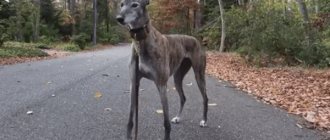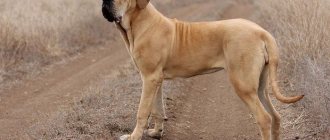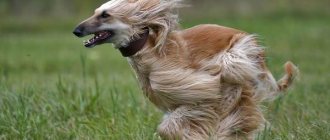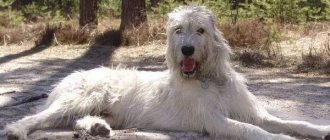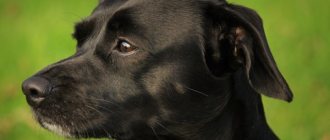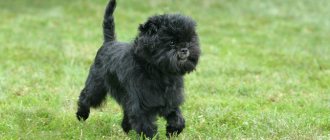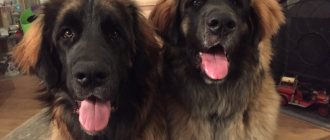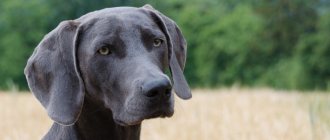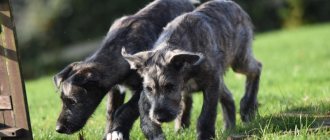Italian Greyhounds are elegant small dogs with an elongated, narrowed head and a rounded loin. Although the animals appear emaciated, they are capable of rapid speed and are rightly considered the embodiment of grace.
Gentle and affectionate dogs easily adapt to the rhythm of life of their owners, but do not tolerate neglectful treatment. Therefore, it doesn’t hurt to find out not only what Italian greyhounds are, but also what features are hidden behind the external fragility of the smallest greyhounds.
Brief history of origin
The Italian greyhound, or Italian greyhound, is considered one of the oldest decorative breeds. Its history dates back several thousand years and is shrouded in many legends. It is known that similar dogs were revered back in the days of Ancient Egypt. This is confirmed by the mummified remains of an Italian greyhound, which were found next to the wife of Pharaoh Psammetichus.
According to one legend, it was just such a dog that saved the heir of the Egyptian ruler. The Persians who conquered the country killed the pharaoh and all members of his family, except for his youngest son. The boy was thrown to certain death in the desert. And if it weren’t for the Italian greyhound that warmed him at night, he would have died. Because the dog was shivering from the cold, the bells tied to it began to ring. It was by this sound that the servants found the boy and the Italian greyhound. From that moment on, the quivering pose of the miniature greyhound began to be considered life-saving.
Graceful Italian greyhounds were depicted on Greek vases from the 5th century BC. e. It is assumed that it was from Greece that the tiny greyhounds came to Italy, where they became the favorites of the emperor himself.
Due to difficulties in maintenance, by the beginning of the 20th century, the threat of extinction loomed over the breed. It was possible to restore the population of the small Italian greyhound only after the Second World War.
The breed survived only thanks to the efforts of British breeders, who chose the Greyhound as the standard and added to it the blood of the Miniature Pinscher, Toy Terrier and Whippet.
Characteristics of the Italian Greyhound
| Attachment level | High |
| Friendliness | High |
| Child Friendly | High |
| Loyalty to other pets | High |
| Exercise needs | Average |
| Playfulness | High |
| Energy level | Average |
| Learning ability | Average |
| Intelligence | Average |
| Tendency to bark | Average |
| Shedding amount | Average |
| Attention needs | High |
| Weather tolerance | Low |
Interesting Facts
Over the centuries-old history of the existence of Italian Greyhounds, a lot of interesting things have happened to them:
- There are several versions of the origin of the name of the breed. According to one of them, it comes from the French word lievre, which means “hare”. According to another, more romantic version, the name of the breed has German roots and is translated as “toy of the wind.” The same name was given to the holiday held in Peterhof and dedicated to Catherine II's Italian greyhound named Zemira. After the death of her beloved dog, the empress ordered the construction of a tomb for her, similar to an Egyptian pyramid.
- In different eras, the owners of Italian greyhounds were such celebrities as Cleopatra, Julius Caesar, Francis I, Louis XV and Queen Victoria. And Alphonse de Lamartine dedicated poems to Italian greyhounds and called them “birds on all fours.”
- Italian Greyhound has several alternative names. In various sources, dogs of this breed are referred to as the Italian Greyhound and the Italian Greyhound.
How and what to feed Italian Greyhounds
It is important to choose healthy food for your pet, regardless of breed. Italian Greyhounds generally do not have any special dietary needs and require a quality, balanced dog food.
Some owners choose to feed their IGS a diet of raw food, while others prefer kibble. Either way, talk to your veterinarian to make sure your puppy is getting all the minerals and vitamins he needs to live a long, healthy life.
Italian Greyhounds are eager eaters, so they will happily gobble up treats. To maintain their weight, give treats infrequently and make sure they don't get too much food. It is very important to prevent obesity in Italian Greyhounds, as their thin bones are not designed to carry excess weight.
Make sure your pet is getting the right amount of calories for his size, and consult your veterinarian if you have any questions or concerns about his weight.
Breed description, standards, appearance
Italian Greyhounds are graceful, sophisticated dogs with correct proportions and smooth movements. Externally, Italian greyhounds resemble their closest ancestors - greyhounds - and differ from them only in size. The breed standard was developed in 1968.
According to the official description, Italian greyhounds have the following characteristics:
- The head is flat, narrow, with pronounced eyebrows, a pointed muzzle and a poorly developed occiput. The jaws are strong, with a full set of small white teeth that meet in a scissor bite. Nose with wide, well-opened nostrils. The lobe is black.
- The eyes are round, dark brown, framed by black eyelids.
- The ears are small, raised, with thin, vertically standing cartilage and the flap tilted back.
- The body is square in shape with a muscular, steeply arching neck, a flat back, a slightly arched loin, a wide croup and a narrow chest.
- Limbs are straight and graceful. The feet are oval, with small pads and curved toes.
- The tail is thin, low set, straight at the base, with a curve at the tip.
Size and constitution
The Italian Greyhound is a short, ascetic dog with a refined silhouette and weakly expressed sexual dimorphism. Boys are not much larger than girls. Depending on the gender, the weight of the Italian Greyhound varies between 3.5-5 kg, and the height is 33-38 cm.
Color and coat type
The body of the Italian greyhound is covered with ultra-short, smooth, velvety hair, under which there is no undercoat at all.
According to the standard, the Small Italian Greyhound can have several color options. The following colors are considered acceptable:
- piebald;
- cream;
- blue;
- sand;
- grey;
- pale yellow;
- black;
- ginger;
- lilac;
- white.
Important! Brindle and black and tan Italian Greyhounds are considered not to meet the breed standard and are discarded.
Health and life expectancy
Italian greyhounds are considered to be long-lived breeds. Italian greyhounds live 12-16 years. Although dogs of this breed do not have any special health problems, Italian greyhounds have a predisposition to the following pathologies:
- epilepsy;
- cataract;
- baldness;
- retinal atrophy;
- glaucoma;
- periodontal disease.
Short-haired miniature Italian Greyhounds get cold easily and are often injured when jumping down.
Important! Due to the lack of subcutaneous fat, the Italian Greyhound is sensitive to anesthetics of the barbiturate class and organophosphorus insecticides.
Possible diseases
The same rule applies to Italian greyhounds as to other decorative dogs - the smaller the dog, the longer its life expectancy. Representatives of the Italian Greyhound breed live up to 15-16 years.
And if you take good care of it and take it for “technical inspections” to the veterinarian at least once every six months, then there is a chance that the dog will not catch any disease in its entire life. However, owners should still keep their eyes open and know the typical ailments characteristic of this breed.
The sooner the owner is alerted to signs of some disease, the sooner he will take the dog for diagnosis, and the more effective the treatment will be. The most common diseases are ophthalmological. We are talking about glaucoma, retinal atrophy, corneal dystrophy and cataracts. If you do not keep track of it in time, the disease will lead to complete loss of vision.
In addition, Italian Greyhounds tend to go bald due to dermatitis. Scientifically the disease is called alopecia. You should be more careful about your pet's skin care products and use special shampoos. It is better if they are dry - these products are more gentle.
Among the neurological disorders, Italian Greyhounds can be plagued by epileptic seizures, and problems with the jaw and teeth are expressed in the form of tartar, plaque, and even loss of incisors.
Character and behavior
Italian Greyhounds are affectionate, friendly, and easily adapt to the temperament of their dog owners. Italian Greyhounds are sensitive to the emotional mood of those around them and are frightened by loud, sharp sounds. Dogs have a hard time with their owners' quarrels and are not able to stay in an atmosphere of shouting and swearing for long.
Important! Italian Greyhounds quickly become attached to people and suffer from prolonged separation. Left to their own devices for a long time, Italian greyhounds develop destructive behavior and deteriorate their character. Therefore, it is not advisable to have such dogs for those who spend a lot of time at work.
Italian Greyhounds are very curious and are not afraid of heights. Dogs often climb higher and watch everything that happens around them. Easily excitable and emotional, Italian Greyhounds do not fall into the silent category. Vocal Italian Greyhounds often express their feelings by yelping and barking.
On a note. Dogs of the Italian Greyhound breed have a characteristic feature - slight trembling. It can be not only a consequence of nervous overexcitation of Italian greyhounds, but also a signal of hypothermia.
Breed and other animals
The friendly and non-conflict nature of the Italian greyhound allows her to get along well with small breed dogs and easily find a common language with domestic cats, especially if she grew up with them. Large dogs can accidentally injure the Italian Greyhound. Therefore, it is better to avoid contact with them.
Previously, Italian greyhounds were used to hunt small game, and the dogs still have hunting instincts. Italian Greyhounds perceive ornamental rodents as prey, so they should not be kept together with rats, hamsters and other small animals.
Breed and children
Due to its fragile build and increased susceptibility to injury, the Italian greyhound cannot be taken into families with children of primary preschool age. Such kids do not yet understand how to properly handle a dog and may accidentally harm it.
But with older children, the mini greyhound will easily find a common language and become an excellent playmate for active games. True, the children will have to explain that the Italian greyhound cannot be indulged. Otherwise, the Italian Greyhound will quickly become spoiled.
Breed traits
Breed traits (on a 5-point scale)
| Italian Greyhound (Italian Greyhound) | |||
| Activity | in the house | 3.3 | |
| on the street | 3.7 | ||
| Obedience | training | 2.7 | |
| strangers | 2.2 | ||
| Domination | in family | 1.3 | |
| over dogs | 2.3 | ||
| Defending your territory | from people | 1.3 | |
| from dogs | 2.5 | ||
| Sociability | in family | 4.7 | |
| with strangers | 3 | ||
| with dogs | 3.5 | ||
| Concentration | in family | 1.7 | |
| in front of strangers | 3.2 | ||
| with dogs | 2.3 | ||
| Aggressiveness | in family | 1 | |
| to strangers | 1.7 | ||
| to the dogs | 2.5 | ||
| to cats | 1.8 | ||
| Family behavior | calmness | 2.8 | |
| demand for affection | 4.7 | ||
| excitability | 3.8 | ||
| playfulness | 4.2 | ||
| excessive barking | 1.5 | ||
| behavioral breakdowns | 1.8 | ||
| Tolerance for children | up to 4 years | 3 | |
| over 4 years old | 3.8 | ||
| Institutional use | watchman | 2.7 | |
| bodyguard | 1.2 | ||
This breed is often compared to the following dog breeds: Whippet, English Toy Terrier, Miniature Pinscher (Dwarf Pinscher), Basenji, Chihuahua.
The photo shows what Italian Greyhounds look like:
How to choose a pet
This Italian breed is not popular among a wide range of dog breeders and is classified as rare. A limited number of nurseries are engaged in its breeding, and litters are not numerous. Therefore, buying an Italian Greyhound puppy is not so easy. To be sure that this is an Italian greyhound and not a mixed breed, you need to contact only trusted breeders or certified nurseries.
When choosing an Italian Greyhound puppy, it is recommended to ask:
- presence of genetic tests in parents;
- availability of metrics and veterinary passport;
- conditions of keeping the mother and puppies.
You also need to carefully examine the Italian Greyhound puppy you like and understand whether it meets the breed standard. A typical 2 month old Italian Greyhound should have:
- straight tail without creases or bends;
- acceptable color;
- straight back.
A healthy Italian Greyhound puppy should have clear eyes, a soft belly, clean ears, smooth fur and smooth skin without scratching or rashes. It is important that he does not have an umbilical hernia and an unpleasant odor from his mouth.
Distinctive features
The main features of Italian Greyhounds are:
- The head is long in shape, with pronounced eyebrow arches and flattened cheekbones.
- The nose is distinguished by a dark lobe with large nostrils.
- The muzzle is elongated with a sharp end, dark and tightly set lips.
- The jaw is powerful, with incisors set in a semicircle, not protruding beyond the line.
- The teeth are large, set perpendicular to the jaw, with a scissor bite.
- The eyes are expressive, round in shape, dark in color and not protruding.
- The ears are small in size, set high, raised at the base, and pulled back at the end.
- The tail is covered with hair, thinned towards the base and set low.
- The body is muscular, the back is straight, the sternum is narrow and deep, and the ribs are curved.
- The coat is short, silky and fine, black or gray in color.
- The paws are powerful, long and thin, semicircular with tightly knit toes.
Puppy care
Italian Greyhound puppies move to their permanent home at 2-3 months. By this time, they are already accustomed to adult food and know how to wear a diaper. Therefore, the new owners will only have to show the pet where he can rest, eat and relieve himself.
On a note. To make the adaptation process painless, a thing with the smell of the native “nest”, taken in advance from the breeder, is placed on the baby’s bed.
After the puppy gets comfortable in the new home, they begin to teach him hygiene procedures and a clear routine. And in order not to spoil the little Italian greyhound, she is not allowed to do things that are prohibited to an adult dog.
The Italian Greyhound puppy is not in good health and needs careful handling and routine vaccinations. It is vaccinated with a complex drug, thanks to which immunity is developed:
- to parainfluenza;
- leptospirosis;
- plague;
- rabies;
- corona and parvovirus enteritis.
The first vaccination for an Italian Greyhound puppy is given at 8-9 weeks and repeated after 21 days. In the future, the dog is vaccinated once a year. Before routine vaccination, the Italian greyhound is given anthelmintic drugs, the dosage of which is calculated strictly by weight.
What do Italian Greyhounds get sick of?
If you are purchasing a puppy, always make sure that you are purchasing from a reputable breeder. Breeders must perform health checks before offering any puppy for sale and provide buyers with a health certificate for each puppy. Overall, Italian Greyhounds are healthy dogs with a long lifespan of 13 to 15 years.
Italian Greyhound Diseases You Should Know About:
- Allergy
- Cataracts and other eye problems
- Hypotoroidism
- Hip dysplasia
- Patella dislocation
Care and maintenance
Due to its small size and complete lack of undercoat, the Italian Greyhound cannot live outside. Therefore, it should only be kept at home.
On a note. The Italian Greyhound loves warmth very much and will not miss an opportunity to bask in the owner’s bed. If the owners' plans do not include sleeping with the pet under the same blanket, you can buy a special house for the Italian Greyhound and cover it with something soft.
In general, caring for an Italian greyhound is no different from caring for dogs of other short-haired miniature breeds and comes down to proper feeding, hygiene and timely walking.
Hygiene procedures
To make the Italian Greyhound look attractive, it is provided with appropriate care:
- The eyes of the Italian Greyhound are wiped daily with a cotton pad soaked in a herbal decoction and checked for the presence of unusual discharge. Since they are the weak point of Italian greyhounds, they receive increased attention. If souring, tearing, dryness or redness is detected, the dog is shown to the veterinarian.
- The Italian Greyhound's ears are wiped 2-3 times a week with a cotton swab moistened with a special lotion and examined. If excessive discharge or redness is detected, the animal is scheduled for an appointment with a specialist.
- The Italian greyhound's teeth are cleaned 2-3 times a week with a special brush or silicone brush with a small amount of animal paste. To prevent plaque formation, the dog is given chewable treats.
- The Italian Greyhound's claws are shortened with a nail clipper as they grow. The procedure is carried out as carefully as possible so as not to damage living tissue.
- The coat of the Italian greyhound should be brushed weekly with a natural bristle brush or treated with a grooming glove. This procedure will help get rid of dead hair and improve blood circulation. You need to bathe your Italian Greyhound once a quarter. Frequent washing dries out the skin and harms the dog.
Feeding
Miniature and slender Italian Greyhounds do not need a large amount of food and, if they regularly overeat, may refuse to eat. It is advisable to feed them in a certain place and at approximately the same time.
The meal schedule is developed individually, taking into account the age of the animals:
- up to 8 weeks – 5-6 times a day;
- 2-6 months – 4 times a day;
- 6-12 months – 3 times a day.
One-year-old Italian Greyhounds are switched to two feedings a day.
Industrial feed
This type of nutrition is recommended by many professional breeders. It allows you to provide your dog with a full range of vitamins and nutrients without any hassle.
Dry food for Italian greyhounds is selected individually, taking into account the dog’s age and level of physical activity. When purchasing, pay attention to the composition and expiration dates of the products offered. It is important that it is premium or super premium and does not contain dubious additives such as soy or corn. Products from Royal Canin, Brit Care and Gemon meet these criteria.
On a note. The daily serving size can be found in the table on the food packaging.
Natural feeding
This type of food has its advantages and is good because the owner knows exactly what is in the dog’s bowl. When feeding an Italian greyhound with natural products, its diet should consist of 70-80% lean meat, previously kept in the freezer and scalded with boiling water.
The Italian Greyhound is also given:
- eggs;
- cereals;
- vegetables;
- offal;
- sour milk;
- lean sea fish.
To prevent the Italian greyhound from developing health problems, the following are completely excluded from its diet:
- baked goods;
- pork;
- sweets;
- spices;
- river fish;
- tubular bones;
- food from the master's table.
Walking and exercise
Although an Italian greyhound can be trained to relieve itself in a litter box, it requires regular walks. Deprived of the opportunity to run in the fresh air, the dog becomes nervous and begins to get sick. Since the Italian greyhound has highly developed hunting instincts, it is better to walk it on a leash. After all, even a well-trained small greyhound can suddenly rush after the prey of interest at a speed of up to 40 km/h and get lost or fall under the wheels of a car.
So that the Italian greyhound can throw out the accumulated energy, you can do running, swimming, agility, coursing or frisbee with it.
Important! The short-haired Italian Greyhound does not tolerate low temperatures at all. Therefore, in the cold season, before a walk, she is dressed up in warm, waterproof overalls.
Training and education
The Italian Greyhound is a smart, but very vulnerable dog that does not accept harsh training. She is quite capable of mastering basic commands, but only if the owner manages to awaken her interest in the lessons. For successful results, it is better to start training an Italian greyhound as soon as it appears in the house. During the training process, you need to take into account that the Italian Greyhound is a born manipulator and if you show weakness even once, it will begin to wear out its owner.
Italian Greyhound must be taught:
- to answer the call;
- do not pick up food from the ground;
- follow the commands “Sit!”, “Lie down!” and “Stop!”;
- walk calmly on a leash;
- on command, go to your place.
Without timely socialization, Italian Greyhounds become nervous. In order for the dog to be calm about city noise and other irritants, immediately after the end of quarantine, the puppy and the puppy begin to walk, first in quiet and then in busy places.
General characteristics of the Italian greyhound breed
The Italian Greyhound is also called the Small Italian Greyhound or the Italian Greyhound. The Russian name can be translated from French: lièvre is a hare, and levrier is a greyhound. In Italian, greyhound is also called levriero. Outwardly, these dogs are really similar to most representatives of the greyhound group, but are much smaller in height. Previously, Italian greyhounds were used to hunt partridges and hares. Now he is a loyal and sociable companion.
Italian Greyhounds are small, elegant dogs with smooth short hair, thin limbs and expressive eyes. A feature of the breed is frequent trembling. Minor trembling can appear not only from cold, but also from nervous overexcitation. In behavior, these greyhounds are similar to cats: they also like to climb higher, settle in warmth and comfort, and cannot tolerate water. By nature they are fearless, active, emotional and willful. A former hunter, this dog can run away in pursuit of a bird or even a car.
| Options | Characteristic |
| breed name | Italian greyhound, small Italian greyhound (Italian: Piccolo levriero italiano), Italian greyhound |
| a country | Italy |
| breed group | greyhounds, short-haired greyhounds |
| application | hunter, companion |
| life expectancy | 13-14 years old |
| height | 32-38 cm |
| weight | 3-5 kg |
| temperament | choleric, emotional |
| aggression | low |
| activity | high |
| need for care | minimal, almost no shedding |
| training | difficult to give in |
| character traits | playful, sociable, affectionate, affectionate, obedient, kind |
| behavior patterns | they run fast, jump high, can climb onto cabinets, tables, window sills |
| colors | beige, gray, black |
pros
The Italian Greyhound is a domestic dog that adapts to any lifestyle of its owner. It is suitable for active elderly people, teenagers, it will brighten up loneliness and cheer up. She does not require serious training or complex care. Due to its small size, the Italian Greyhound gets along well in a small apartment; it can be kept in the city or in the countryside. These dogs have many advantages, thanks to which they are popular all over the world:
- playful, cheerful;
- have an attractive appearance;
- sociable, affectionate;
- not aggressive, good-natured;
- smart, feel the emotional state of a person;
- loyal, strongly attached to the owner;
- get along well with other dogs;
- clean, the coat hardly sheds and does not smell like a dog;
- love children, can be nannies;
- They have good health and are unpretentious.
Minuses
This breed is not suitable for everyone. Lovers of decorative dogs may not like the excessive emotionality, activity and jumping ability of Italian greyhounds. And for those who need a companion for long walks and hikes, it is necessary to take into account their fragility of physique and low endurance. These dogs are also not used for hunting, although they still have hunting instincts.
But the main drawback of Italian Greyhounds is their intolerance of loneliness. These dogs constantly require the presence of the owner, attention, communication and tactile contact. Therefore, busy people who are rarely at home should not get representatives of this breed. Italian Greyhounds have a few more disadvantages:
- may be intrusive;
- love to lick a person's face;
- playful, climbing on tables and cabinets;
- very emotional, prone to stress;
- often bark, squeal, whine;
- They are afraid of the cold; in the cold season they need clothing.
The video complements the characteristics of the breed:
Video: Italian Greyhound on ilikepet. Breed characteristics, care
Video: Italian Greyhound. Zooplace.Ru
Video: Italian Greyhound. Pros and cons, price, how to choose, facts, care, history
Puberty and mating
The Italian Greyhound reaches sexual maturity at 8-10 months. But it is recommended to steam a dog no earlier than 1.5 years. Only vaccinated and absolutely healthy representatives of the breed that meet the standard are allowed to mate.
Mating is carried out on the 11-15th day from the start of estrus. Before this, the dogs are given a good walk and not fed. For mating to be successful, it is organized on neutral territory or where the male lives. It is advisable to repeat the mating the next day. If fertilization has taken place, then on the 60-64th day the Italian greyhound will give birth to 2-4 puppies.
Other Breeds to Study
Before you decide to get an Italian Greyhound, study their character and habits, talk to other breed owners and reputable breeders to learn more.
If you're interested in similar breeds, check out their profiles to compare the pros and cons:
Greyhound (English greyhound)
Whippet
Afghan Hound
Saluki
There are many breeds of dogs, with careful research you can find a pet that suits you and bring it into your home.
Italian greyhound price
The cost of an Italian Greyhound puppy varies widely. It depends on the origin of the dog and its future prospects:
- The cheapest puppy is one without documents or with obvious defects. Its price is 5-10 thousand rubles.
- A puppy with a good pedigree costs on average 30-40 thousand rubles.
- For a descendant of international champions with the prospect of an exhibition career, you will have to pay 50-80 thousand rubles.
The Italian Greyhound is a graceful miniature greyhound with a rich history and a timid, sensitive nature. She will be an excellent companion for non-conflict people who can surround her with care and attention.
Italian greyhound character
The Italian Greyhound is an excellent companion. She is loyal, sociable, friendly and affectionate. By type of temperament, she is rather choleric, quite emotional, easily excitable. The peculiarity of these dogs is that they constantly require human contact and attention; they cannot stand loneliness. Therefore, the breed is not suitable for people who love peace and do not tolerate violation of personal space.
When getting an Italian greyhound, you need to immediately prepare for the fact that the pet will try to climb onto your lap, into the bed, and lick your hands and face. This dog is ready to spend hours next to its owner, and can even be annoying. Italian Greyhounds are very curious, they love to poke their noses everywhere, climb into closets, and participate in all the owner’s activities. It is useless to wean your dog off of this.
Italian Greyhounds love to “talk”, expressing their emotions by squealing, whining and barking. These dogs are very impressionable; they do not tolerate rude attitudes, conflicts, raised voices and loud noises. They also love comfort and softness, so it is difficult to wean your pet from crawling under a blanket or sleeping on the sofa.
Representatives of this breed are characterized by the following character traits:
- goodwill;
- emotionality;
- impressionability;
- devotion;
- sociability;
- playfulness;
- sensitivity;
- curiosity;
- intelligence;
- cunning;
- agreeableness;
- touchiness.
These dogs mature quite slowly. And until 1-2 years of age, they behave like puppies: they like to play pranks and chew things. Another feature of them is their extraordinary jumping ability and the desire to climb higher. Italian Greyhounds, like cats, love to sit on the windowsill, chairs, bedside tables, and are not shy about climbing even on tables. They are not afraid of heights, so they often fall and get injured.
Italian Greyhounds are a hunting breed of dog. Although they have not been used for hunting for a long time, this is reflected in their behavior. These are greyhounds, they love to run and are capable of developing great speed. Their sense of smell is not very good, but their eyesight is sharp. Friendly and friendly with other dogs and even cats, Italian greyhounds do not like rodents and birds. They perceive them as prey and try to catch them on the street. Often these dogs even start chasing cars.
Italian greyhounds treat strangers with restraint, wariness, but without aggression. They are vigilant, warn their owner about the approach of strangers and will not allow themselves to be offended. But due to their fragile physique, they make poor guards.
Italian Greyhounds easily make contact with children and quickly find a common language. They love playing together, are patient with pranks and do not show aggression. But this breed is more suitable for children over 7 years old who understand how to behave with a pet. Italian Greyhounds are very impressionable, emotional, and have fragile bones. Toddlers can accidentally injure or frighten the dog.
Education and training
Italian Greyhounds are very smart and quick-witted, but they are difficult to train. They are quite lazy and independent, they do not like to follow commands the first time, even for a treat. Although in most cases they understand what is required of them. They do not show zeal in training; they often test the owner’s patience, trying to dominate him. These dogs are manipulators, naughty and pranksters.
Therefore, from the first day the puppy appears in the house, it is necessary to gain authority from him. You immediately need to establish rules of behavior and boundaries of what is permitted, which all family members will observe. Once you deviate from the rules and allow some relaxation, the greyhound will remember this. Early socialization is also important so that the dog does not grow up intimidated and anxious.
But you can still raise an obedient pet from an Italian greyhound. He will not unquestioningly follow commands like a service dog, but he will not create problems. You just need to take into account the individual characteristics of the breed:
- these dogs are sensitive to any punishment or raising their voice, but unwanted behavior must be stopped immediately;
- you cannot scold or punish a dog in its place, it will not be able to sleep there;
- puppies choose one owner, who must be trained from the first days;
- You immediately need to accustom your pet to its name, place, and daily routine;
- It’s better to train this dog to go to the toilet using a tray or diaper, they don’t know how to tolerate it;
- classes should be short and varied;
- Don’t rush into training or put pressure on your pet;
- you need to practice regularly, consistently, study no more than one command at a time;
- you need to be persistent and patient.
It is recommended to contact a dog trainer and take a General training course aimed at greyhounds. It is also worth visiting dog parks regularly and engaging in sports with your Italian greyhound. She needs physical activity, without which she will throw out her energy in pranks. These dogs enjoy coursing, agility, and Frisbee.
Photos illustrate the behavioral features of these dogs:
brief information
| ICF classification | 10. Greyhounds |
| |
| Country of origin | Italy |
| Weight | Up to 5 kg |
| Height | 32-40 cm |
| Wool | Smooth |
| Color | White, red, black, sand, blue, gray, fawn, lilac, cream. |
| Life cycle | 12-16 years old |
